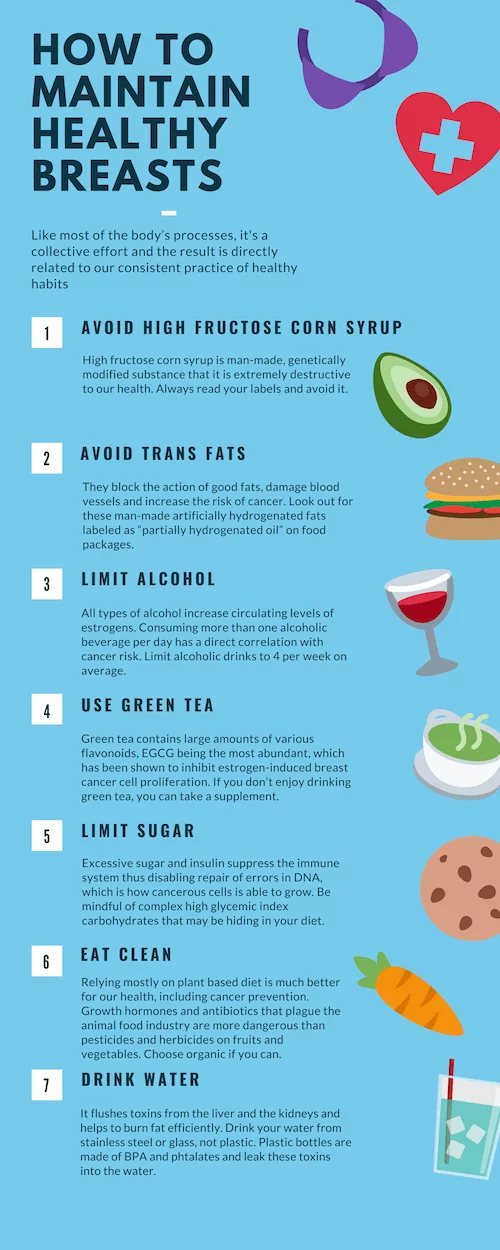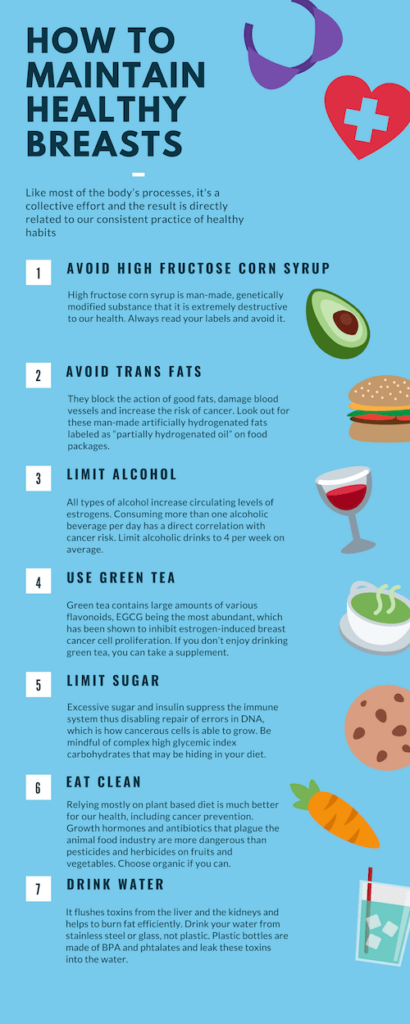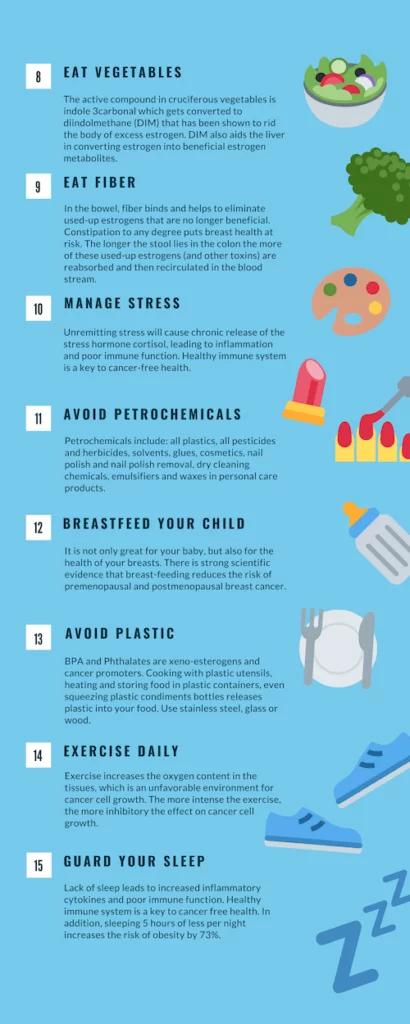
[et_pb_section fb_built=”1″ _builder_version=”3.22″][et_pb_row _builder_version=”3.25″ background_size=”initial” background_position=”top_left” background_repeat=”repeat”][et_pb_column type=”4_4″ _builder_version=”3.25″ custom_padding=”|||” custom_padding__hover=”|||”][et_pb_text _builder_version=”3.26.6″ background_size=”initial” background_position=”top_left” background_repeat=”repeat”]
Written By: Kamila Seilhan, DO
October marks Breast Cancer Awareness Month worldwide.
While there is no consensus on the cause of breast cancer, there is sufficient scientific evidence on what can reduce the risks of developing it. And, the influence we have regarding the ability to promote healthy breast tissue or reverse abnormalities is very high – more than 80% !!!
Like most of the body’s processes, it is a collective effort and the result is directly related to our consistent practice of healthy habits. So let us engage in a proactive mindset and take positive actions, there is no need to live in fear
Breast cancer is by far the most common cancer in women in the world, both in developed and developing countries. According to the WHO, the incidence has been rising steadily, especially in developing countries due to the increase in urbanization and the adoption of western lifestyles.
Does that make you wonder?
Here are 15 decision points that you can control on a daily basis that will reduce your risk.
 Action 1 – Avoid PLASTIC
Action 1 – Avoid PLASTIC
BPA (bisphenol A) and Phthalates are xeno-esterogens and cancer promoters. Xenoestrogens are chemicals that imitate estrogen in the body with hazardous outcomes. Main sources of xeno-estrogens include plastics and pesticides. Cooking with plastic utensils, heating and storing food in plastic containers, even squeezing plastic condiments bottles releases xeno-estrogens and phthalates into your food. Use stainless steel, glass or wood, the benefit will extend far beyond your kitchen.
Action 2 – Avoid HIGH FRUCTOSE CORN SYRUP
High fructose corn syrup is man-made, genetically modified substance that it is extremely destructive to our health. It can only be metabolized by the liver and as such, once ingested, it monopolizes the activity of the liver leaving other important detoxification processes unaddressed. Please, read your labels and avoid it like a plague!
Action 3 – Avoid TRANS FATS
Trans fats are man-made artificially hydrogenated fats labeled as “partially hydrogenated oil” on food packages. They are used in processed foods and convenience foods. They block the action of good fats, damage blood vessels and increase the risk of cancer (and heart disease). High in omega 6 fats, they create inflammatory prostaglandins in the body thus increasing free radical-mediated DNA damage. Please, read your labels and avoid them.
Action 4 – Limit ALCOHOL
Enjoy your life but limit alcoholic drinks to 4 per week on average. All types of alcohol increase circulating levels of estrogens. Scientific literature shows that consuming more than one alcoholic beverage per day has a direct correlation with cancer risk. In addition, excessive alcohol will increase the acidic state of the body which is an environment that can promote cancer.
Action 5 – Use GREEN TEA
Green tea contains large amounts of various flavonoids, EGCG being the most abundant. EGCG has been shown to inhibit estrogen-induced breast cancer cell proliferation. Be cautious with caffeine however, daily intake should not exceed 250 mg (tea or coffee). Caffeine alters the p53 suppressor gene which is key in inhibiting abnormal precancerous cell growth. If you don’t enjoy drinking green tea, you can take a supplement (e.g. Decaffeinated Mega Green Tea Extract from LifeExtensions is great).
1 cup of regular green tea = 35 mg caffeine
1 cup of Matcha = 250 mg caffeine
Regular coffee = 120 mg caffeine
Starbucks venti = 400mg (yikes!!!)
Action 6 – Limit SUGAR
Excess sugar, and uncontrolled insulin that results, both feed cancer cells. Further, excessive sugar and insulin suppress the immune system thus disabling repair of errors in DNA which is how cancerous cells is able to grow. Occasional treat is not a problem but in general, simple sugars should be especially limited. Be mindful of complex high glycemic index carbohydrates that may be hiding in your diet.
Action 7 – Eat clean PLANT-BASED diet
Studies show us over and over again that relying mostly on a plant-based diet is much better for our health, including cancer prevention. Additionally, growth hormones and antibiotics that plague the animal food industry in the US, and to a lesser degree in Europe, are more dangerous than pesticides and herbicides on fruits and vegetables. Choose organic if you can. Otherwise, look for fruit and vegetable wash that naturally cleans chemical residue on conventionally grown produce.
Action 8 – Eat CRUCIFEROUS VEGETABLES daily
The active compound in these vegetables is indole 3carbonal which gets converted to diindolylmethane (DIM) that has been shown to rid the body of excess estrogen. DIM also aids the liver in converting estrogen into beneficial estrogen metabolites. Thus influencing the hormone balance, cruciferous vegetables reduce the risk of many different types of cancer including prostate cancer in men. Consume one cup raw or ½ cup cooked daily.
 Action 9 – Eat 35 grams of FIBER daily
Action 9 – Eat 35 grams of FIBER daily
In the bowel, fiber binds and helps to eliminate used-up estrogens that are no longer beneficial. Constipation to any degree puts breast health at risk. The longer the stool lies in the colon the more of these used-up estrogens (and other toxins) are reabsorbed and then recirculated in the bloodstream. Additionally, fiber feeds the cells in the bowel lining which comprises 70% of the immune system. Healthy immune system is a key to cancer free health. Rely mostly on vegetables, legumes, seeds and nuts as a source.
Action 10 – Drink 2 liters of clean WATER daily
Water is the basic elixir of life. It flushes toxins from the liver and the kidneys and helps to burn fat efficiently. Water should come from a good filtered source such as a home reverse osmosis or micro pore system. These systems are inexpensive and remove toxins, pesticides, herbicides, drugs, and chlorine from water. Drink your water from stainless steel or glass, not plastic. Plastic bottles are made of BPA and phthalates and leak these toxins into the water. Bisphenol A is a known cancer promoter and should be aggressively avoided.
Action 11 – EXERCISE daily
Exercise increases the oxygen content in the tissues which is an unfavorable environment for cancer cell growth. Studies show that the more intense the exercise the more inhibitory the effect on cancer cell growth. Further, vigorous exercise leads to sweating which is an excellent way to remove toxins, including heavy metals, from the body. Exercise also aids in efficient fat burning; the link between obesity and increased risk of cancer is well established.
Action 12 – Guard your SLEEP
Lack of sleep leads to increased inflammatory cytokines and poor immune function. Healthy immune system is a key to cancer free health. In addition, sleeping 5 hours of less per night increases the risk of obesity by 73%. Obesity is directly linked to increased risk of cancer. Sleep is critically important so don’t take your sleep cycle for granted. Get help if this is a problem for you.
Action 13 – Manage STRESS
Unremitting stress will cause chronic release of the stress hormone cortisol, leading to inflammation and poor immune function. Healthy immune system is a key to cancer free health. Make your best effort to manage your stress. Get help if this is a problem for you.
Action 14 – Avoid PETROCHEMICALS
Petrochemicals include all plastics, all pesticides, and herbicides, solvents, glues, cosmetics, nail polish and nail polish removal, dry cleaning chemicals, emulsifiers and waxes in personal care products. We can not live in a bubble but we can choose to reduce exposure as much as possible by choosing all-natural products.
Toxic Ingredients to avoid – Read your labels!
- Parabens (methyl, propyl, butyl, isobutyl, ethyl)
- Mineral oil (petrolatum, petroleum, paraffin)
- Propylene glycol/butylene glycol
- Silicone (dimethicone, Cyclomethicone)
- Dibutyl phthalate
- 1.4-Dioxane ***
- BHT (butylated hydroxyl-toluene)
- BHA (butylated hydroxyanisole)
- Benzalkonium chloride
- Benzethonium chloride
- Triclosan / Triclocarban
- DEA (diethanolamine)
- MEA (monoethanolamine)
- TEA (triethanolamine)
- Talc*** Dioxane won’t appear in ingredients! Keywords to look for and avoid are “anti-bacterial”, “emulsifier”, “PEGs” and “SLS”
Action 15 – BREAST-FEED your child
At least give it a try, if you can. It is not only great for your baby but also for the health of your breasts. There is strong scientific evidence that breastfeeding reduces the risk of premenopausal and postmenopausal breast cancer. Breastfeeding longer than the recommended six months can provide additional protection.
[/et_pb_text][/et_pb_column][/et_pb_row][et_pb_row _builder_version=”3.26.6″][et_pb_column type=”4_4″ _builder_version=”3.26.6″][et_pb_text _builder_version=”3.26.6″ text_font_size=”10px”]
References:
1.
-Health risk of exposure to Bisphenol A (BPA).Konieczna A. Rocz Panstw Zakl Hig. 2015;66(1)
-Assessing the carcinogenic potential of low-dose exposures to chemical mixtures in the environment.William H. Goodson. Carcinogenesis, Vol 36, pages P254–S296. June 2015.
-Is bisphenol A an environmental obesogen?
Legeay S1,Fundam Clin Pharmacol. 2017 Dec;31(6):594-609. Epub 2017 Jul 7.
-Insight into breast cancer. Komal Talreja. International Journal of Life science. Vol 5/ issue 3/ July 2015
2.
-The role of fructose in metabolism and cancer. Charrez B. Horm Mol Biol Clin Investig. 2015 May;22(2):79-89.
-Obesity-dependent changes in interstitial ECM mechanics promote breast tumorigenesis. Priya Bhardwaj, Patrick G. Morris. Science Translational Medicine. 19 Aug 2015:
-Priorities for the primary prevention of breast cancer. Graham A. Colditz MD, DrPH Kari Bohlke ScD. CA Cancer J Clin 2014;64:186–194.
3.
-Preventing breast cancer now by acting on what we already know. Journal of Breast Cancer. Graham A Colditz, Kari Bohlke. Volume 1, article number: 15009 (2015)
-Priorities for the primary prevention of breast cancer. Graham A. Colditz MD, DrPH Kari Bohlke ScD. CA Cancer J Clin 2014;64:186–194
4.
-Link Between Breast Cancer Risk and Alcohol. Continuous Update Project Report: Diet, nutrition, physical activity and breast cancer. Published online on May 23, 2017
-Early Breast Cancer Prevention. Journal of Breast Cancer. Published online on July 22, 2015.
-Priorities for the primary prevention of breast cancer. Graham A. Colditz MD, DrPH Kari Bohlke ScD. CA Cancer J Clin 2014;64:186–194
5.
-Green tea compounds in breast cancer prevention and treatment. Min-Jing Li. World J Clin Oncol. 2014 Aug 10; 5(3): 520–528.
-Associations of coffee, tea and caffeine intake with risk of breast, endometrial and ovarian cancer among Canadian women. Arthur R. Cancer Epidemiol. 2018 Oct
-Prospective study of breast cancer in relation to coffee, tea and caffeine in Sweden.
Oh JK. Int J Cancer. 2015 Oct 15;137(8):1979-89.
-Coffee and caffeine intake and breast cancer risk. Jiang W. Gynecol Oncol. 2013 Jun
6.
-Preventing breast cancer now by acting on what we already know. Journal of Breast Cancer. Graham A Colditz, Kari Bohlke. Volume 1, article: 15009 (2015)
-Priorities for the primary prevention of breast cancer. Graham A. Colditz MD, DrPH Kari Bohlke ScD. CA Cancer J Clin 2014;64:186–194.
-Obesity-dependent changes in interstitial ECM mechanics promote breast tumorigenesis. Priya Bhardwaj, Patrick G. Morris. Science Translational Medicine 19 Aug 2015: Vol. 7, Issue 301, pp. 301ra130.
7.
-Preventing breast cancer now by acting on what we already know. Journal of Breast Cancer. Graham A Colditz, Kari Bohlke. Volume 1, article number: 15009 (2015)
-Priorities for the primary prevention of breast cancer. Graham A. Colditz MD, DrPH Kari Bohlke ScD. CA Cancer J Clin 2014;64:186–194
-Obesity-dependent changes in interstitial ECM mechanics promote breast tumorigenesis. Priya Bhardwaj, Patrick G. Morris. Science Translational Medicine 19 Aug 2015: Vol. 7, Issue 301, pp. 301ra130.
8.
-Anti-Carcinogenic Glucosinolates in Cruciferous Vegetables and Their Antagonistic Effects on Prevention of Cancers. Soundararajan P. Molecules. 2018 Nov 15;23(11)
-Trends in Cruciferous Vegetable Consumption and Associations with Breast Cancer Risk. Lin T. Curr Dev Nutr. 2017 Jul 18;1(8)
-Temporal Efficacy of a Sulforaphane-Based Broccoli Sprout Diet in Prevention of Breast Cancer through Modulation of Epigenetic Mechanisms. Buckhaults P. Cancer Prev Res (Phila). 2018 Aug;11(8):451-464.
9.
-Effect of dietary fiber intake on breast cancer risk. Zhang CX. Eur J Clin Nutr. Aug 2011
-Preventing breast cancer now by acting on what we already know. Journal of Breast Cancer. Graham A Colditz, Kari Bohlke. Volume 1, article number: 15009 (2015)
-Priorities for the primary prevention of breast cancer. Graham A. Colditz MD, DrPH Kari Bohlke ScD. CA Cancer J Clin 2014;64:186–194
10.
-Water intake and cancer prevention. Bar David Y, J Clin Oncol. 2004 Jan 15;22(2):383-5.
-Priorities for the primary prevention of breast cancer. Graham A. Colditz MD, DrPH Kari Bohlke ScD. CA Cancer J Clin 2014;64:186–194
-Preventing breast cancer now by acting on what we already know. Journal of Breast Cancer. Graham A Colditz, Kari Bohlke. Volume 1, article number: 15009 (2015)
-Obesity-dependent changes in interstitial ECM mechanics promote breast tumorigenesis. Priya Bhardwaj, Patrick G. Morris. Science Translational Medicine 19 Aug 2015: Vol. 7, Issue 301, pp. 301ra130.
11.
-Water intake and cancer prevention. Bar David Y, J Clin Oncol. 2004 Jan 15;22(2):383-5.
-Priorities for the primary prevention of breast cancer. Graham A. Colditz MD, DrPH Kari Bohlke ScD. CA Cancer J Clin 2014;64:186–194
-Preventing breast cancer now by acting on what we already know. Journal of Breast Cancer. Graham A Colditz, Kari Bohlke. Volume 1, article number: 15009 (2015)
-Obesity-dependent changes in interstitial ECM mechanics promote breast tumorigenesis. Priya Bhardwaj, Patrick G. Morris. Science Translational Medicine 19 Aug 2015: Vol. 7, Issue 301, pp. 301ra130.
12.
-Preventing breast cancer now by acting on what we already know. Journal of Breast Cancer. Graham A Colditz, Kari Bohlke. Volume 1, article number: 15009 (2015)
-Priorities for the primary prevention of breast cancer. Graham A. Colditz MD, DrPH Kari Bohlke ScD. CA Cancer J Clin 2014;64:186–194.
-Obesity-dependent changes in interstitial ECM mechanics promote breast tumorigenesis. Priya Bhardwaj, Patrick G. Morris. Science Translational Medicine 19 Aug 2015: Vol. 7, Issue 301, pp. 301ra130.
13.
-The relation between stressful life events and breast cancer: a systematic review and meta-analysis of cohort studies. Bahri N. Breast Cancer Res Treat. 2019 Jul;176(1):53-61.
-Stressful life events increase breast cancer risk. Fischer A. J Psychosom Res. 2018 Jul
-Psychological stress and breast cancer incidence: a systematic review. Chiriac VF. Clujul Med. 2018;91(1):18-26.
14.
-Environmental chemicals and breast cancer: An updated review of epidemiological literature informed by biological mechanisms. Kathryn M.Rodgers. Journal Environmental Research. Published October 6 2017.
-Assessing the carcinogenic potential of low-dose exposures to chemical mixtures in the environment.William H. Goodson. Carcinogenesis, Vol 36, pages P254–S296. June 2015.
-Preventing breast cancer now by acting on what we already know. Journal of Breast Cancer. Graham A Colditz, Kari Bohlke. Volume 1, article number: 15009 (2015)
15.
-Breast cancer and breastfeeding. Collaborative Group on Hormonal Factors in Breast Cancer, Lancet. 2002.
-Priorities for the primary prevention of breast cancer. Graham A. Colditz MD, DrPH Kari Bohlke ScD. CA Cancer J Clin 2014;64:186–194
[/et_pb_text][/et_pb_column][/et_pb_row][/et_pb_section]




